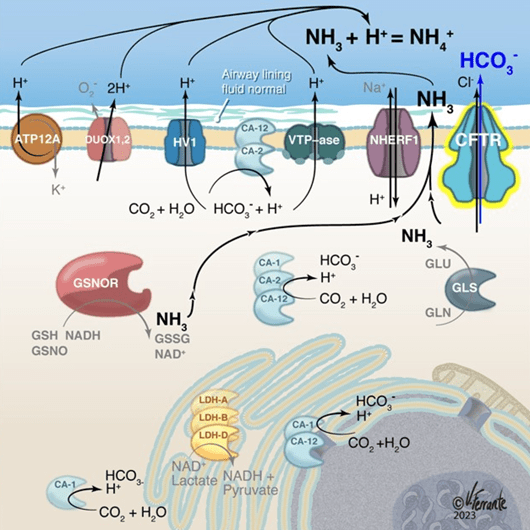
The airway epithelium, like the renal tubular epithelium, expresses proteins that regulate luminal pH. For example, glutaminase regulates ammonia production; it is inhibited by Th1 cytokines, acidifying the airway. Cystic fibrosis transmembrane regulatory protein regulates outward HCO3 - transit, and its absence results in luminal acidification. Decreased airway lining fluid pH can promote airway inflammation as well as viral and bacterial replication. We hypothesize that the distal airway epithelial surface is acidic, both because of high CO2 levels and low- pH lamellar bodies; that pH increases as airway lining fluid is swept proximally; and that impaired airway luminal buffering can contribute to the pathophysiology of asthma. In particular, there is evidence that acute asthma exacerbations are associated with a fall in airway luminal pH; an effect reversed by glucocorticoids. Further, some asthma patients have a low luminal pH at baseline. Here, we will study the cellular determinants of airway pH regulation. We will make use of the effect of airway pH to alter airway NO metabolism and bioactivities (Project 1) to map the location and effects of low pH in the asthmatic airway in vivo. We will study the recently discovered effects of androgens (Project 3) to promote the expression of beneficial pH regulatory enzymes in asthma. Finally, we will study the potential benefit of inhaled buffer in asthma patients with exacerbations. Specifically, we will carry out three aims.
In Aim 1, we will characterize the cellular determinants of airway pH. In Aim 2, we will map the epithelial pH of the normal and asthmatic airway. In Aim 3, we will measure the effect of inhaled buffer on inflammation and response to β2 agonists in asthma. At the end of the project, we anticipate having mapped both the cellular regulation of airway epithelial pH and the anatomic variations in airway pH in health and in asthma; and we will have developed a new, personalized approach to target pH abnormalities in patients with asthma exacerbations.